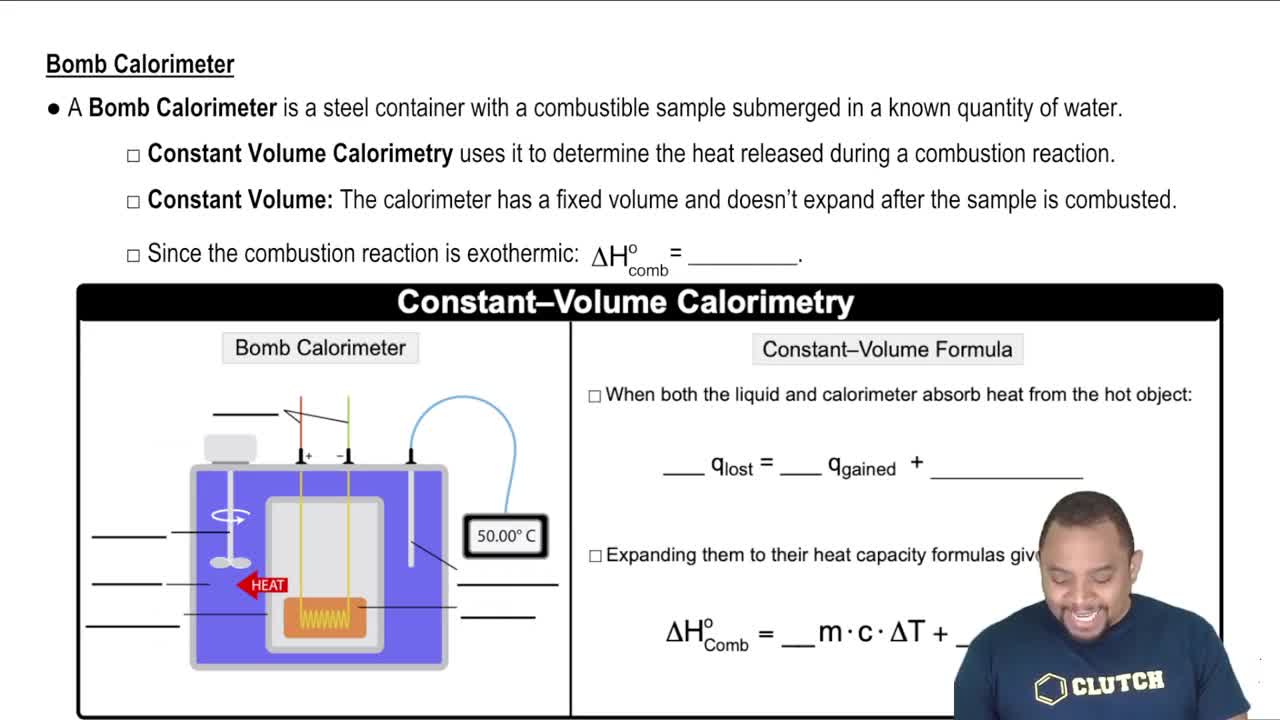A rechargeable battery is constructed based on a concentration cell constructed of two Ag/Ag+ half-cells. The volume of each half-cell is 2.0 L, and the concentrations of Ag+ in the half-cells are 1.25 M and 1.0 × 10–3 M. b. What mass of silver is plated onto the cathode by running at 3.5 A for 5.5 h?
Ch.19 - Electrochemistry
Chapter 19, Problem 118
When a suspected drunk driver blows 188 mL of their breath through the fuel-cell breathalyzer described in Section 19.7, the breathalyzer produces an average of 324 mA of current for 10 s. Assuming a pressure of 1.0 atm and a temperature of 25 °C, what percent (by volume) of the driver’s breath is ethanol?
 Verified step by step guidance
Verified step by step guidance1
Convert the volume of breath from mL to L by dividing by 1000.
Use the ideal gas law, PV = nRT, to calculate the number of moles of gas in the breath sample. Use P = 1.0 atm, V = volume in L, R = 0.0821 L·atm/mol·K, and T = 298 K (25 °C).
Calculate the total charge (Q) passed through the breathalyzer using the formula Q = I × t, where I is the current in amperes (324 mA converted to A) and t is the time in seconds (10 s).
Determine the number of moles of electrons transferred using the relationship between charge and moles of electrons: moles of electrons = Q / F, where F is Faraday's constant (96485 C/mol).
Assuming complete oxidation of ethanol (C2H5OH) to acetic acid (CH3COOH), use the stoichiometry of the reaction to find the moles of ethanol. Then, calculate the volume percent of ethanol in the breath by dividing the moles of ethanol by the total moles of gas and multiplying by 100.
Key Concepts
Here are the essential concepts you must grasp in order to answer the question correctly.
Electrochemical Reactions
Electrochemical reactions involve the transfer of electrons between chemical species, which can be harnessed to measure concentrations of substances. In a breathalyzer, ethanol in the breath undergoes oxidation at the anode, producing a measurable current that correlates with its concentration. Understanding these reactions is crucial for interpreting the data from the breathalyzer.
Recommended video:
Guided course

Electrochemical Cells
Ideal Gas Law
The Ideal Gas Law (PV = nRT) relates the pressure, volume, temperature, and number of moles of a gas. In this scenario, it helps determine the number of moles of ethanol vapor present in the driver's breath sample. This relationship is essential for converting the measured volume of breath into moles, which can then be used to calculate the concentration of ethanol.
Recommended video:
Guided course

Ideal Gas Law Formula
Concentration and Percent by Volume
Concentration refers to the amount of a substance in a given volume of solution, and percent by volume is a way to express this concentration. It is calculated as the volume of the solute divided by the total volume of the solution, multiplied by 100. In this case, determining the percent by volume of ethanol in the driver's breath requires knowing the volume of ethanol present relative to the total volume of breath analyzed.
Recommended video:
Guided course

Constant-Volume Calorimetry
Related Practice
Textbook Question
Textbook Question
A rechargeable battery is constructed based on a concentration cell constructed of two Ag/Ag+ half-cells. The volume of each half-cell is 2.0 L, and the concentrations of Ag+ in the half-cells are 1.25 M and 1.0 × 10–3 M. c. Upon recharging, how long would it take to redissolve 1.00 × 102 g of silver at a charging current of 10.0 amps?
Textbook Question
Calculate ∆G°rxn and K for each reaction.
a. The disproportionation of Mn2+(aq) to Mn(s) and MnO2(s) in acid solution at 25 °C.
b. The disproportionation of MnO2(s) to Mn2+(aq) and MnO4–(aq) in acid solution at 25 °C.
Textbook Question
Calculate ∆G°rxn and K for each reaction. a. The reaction of Cr2+(aq) with Cr2O72–(aq) in acid solution to form Cr3+(aq).
